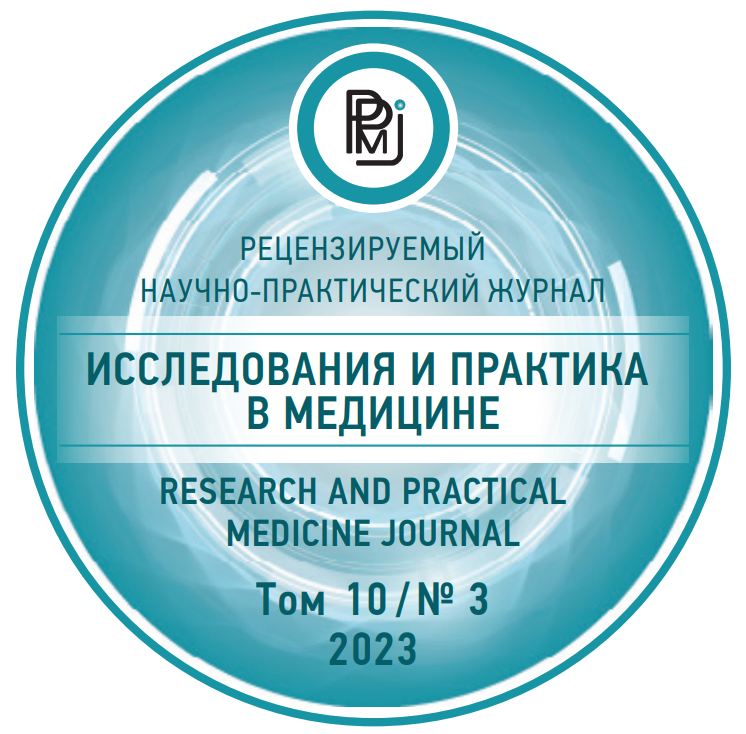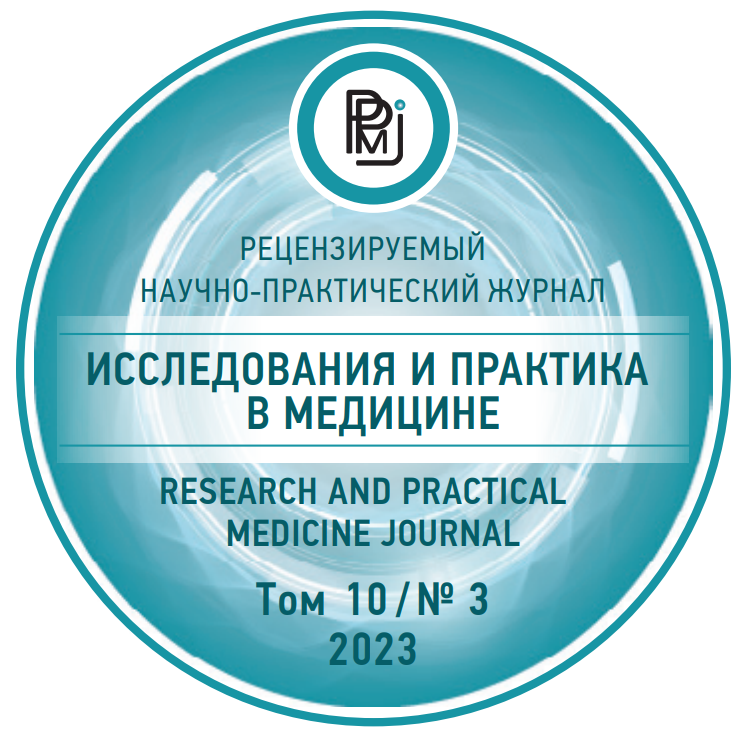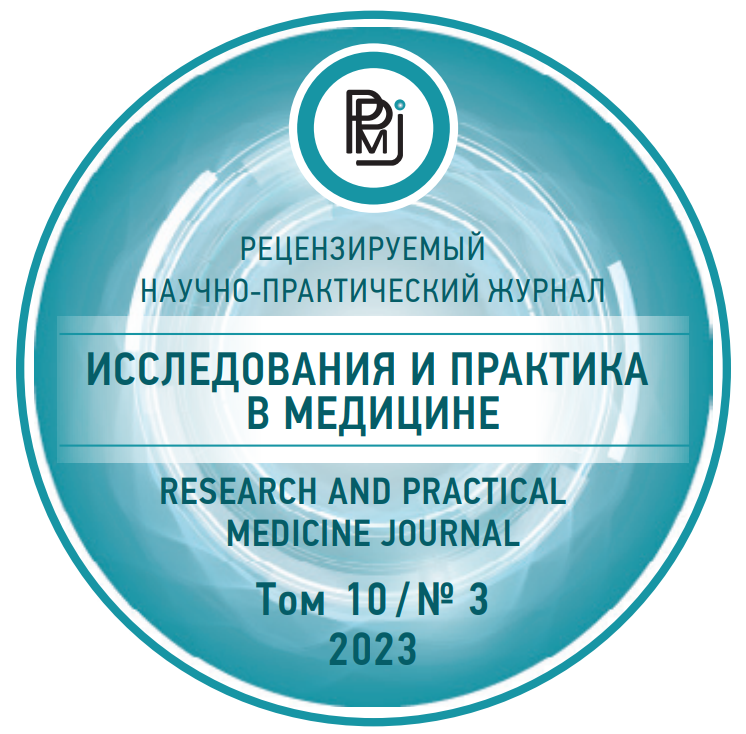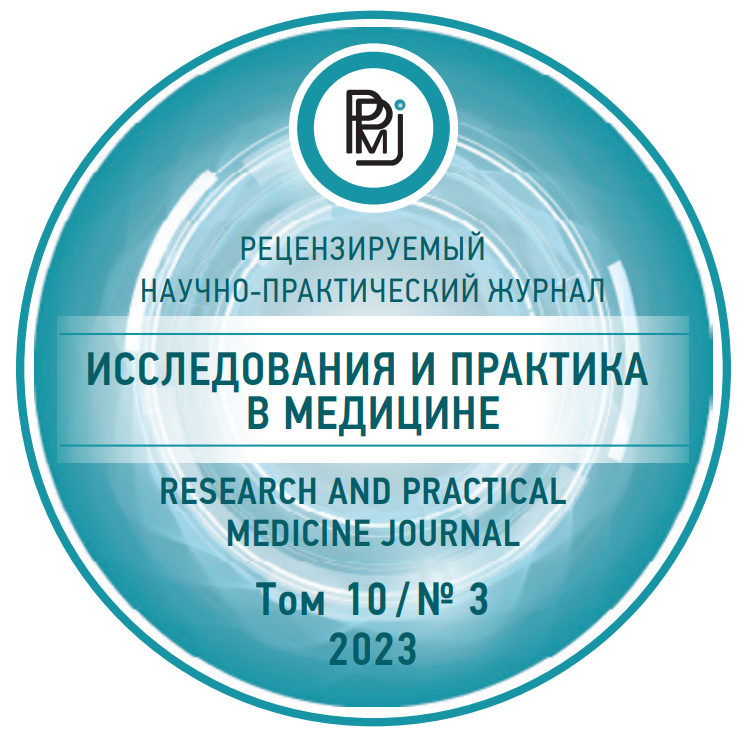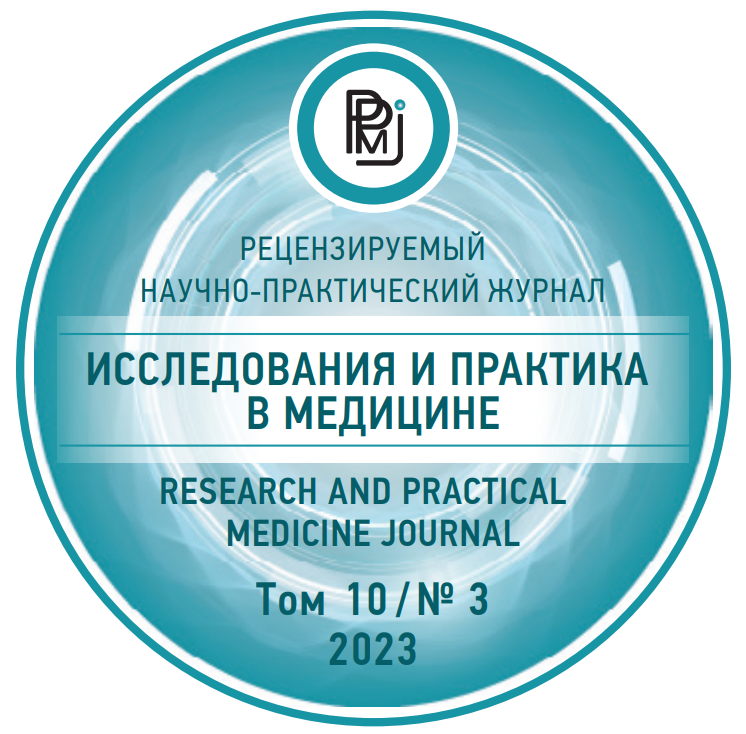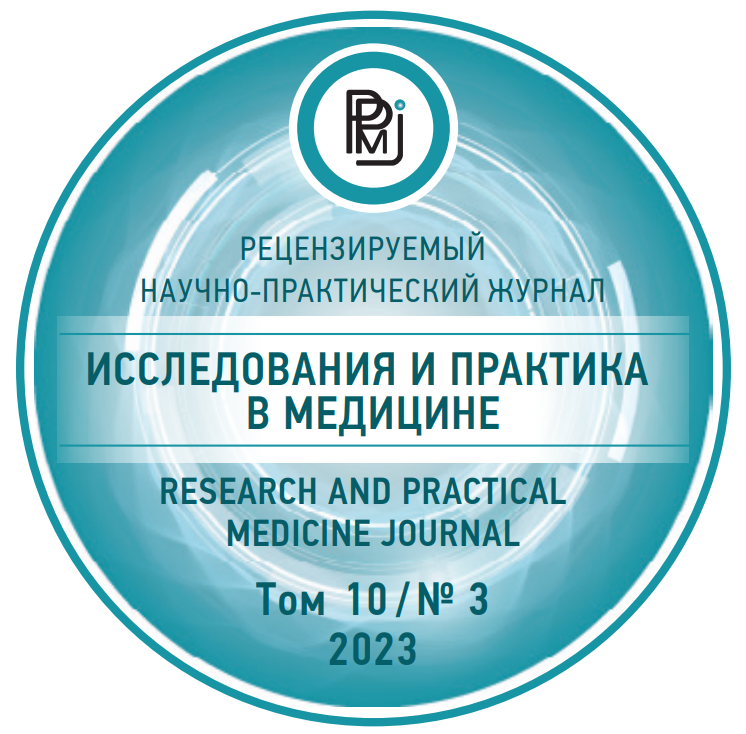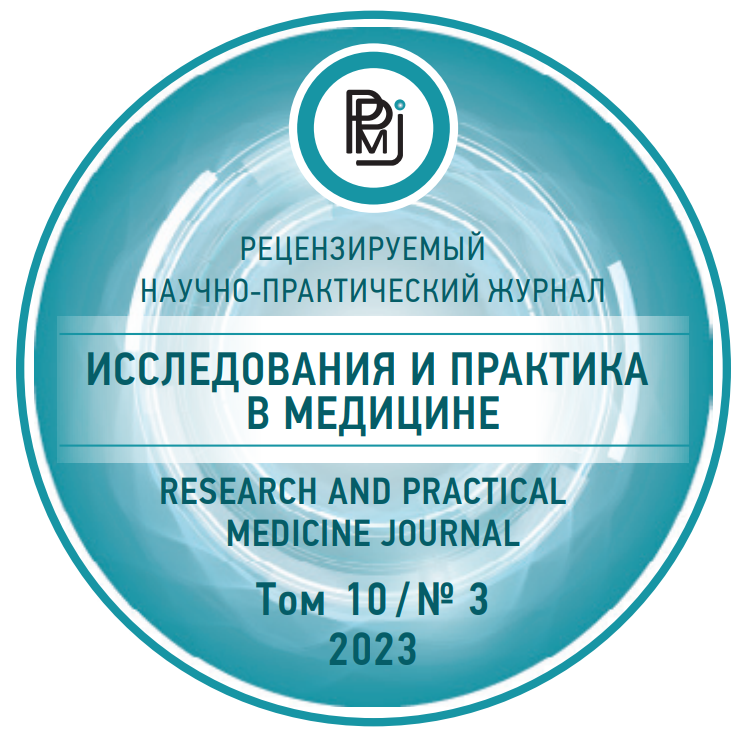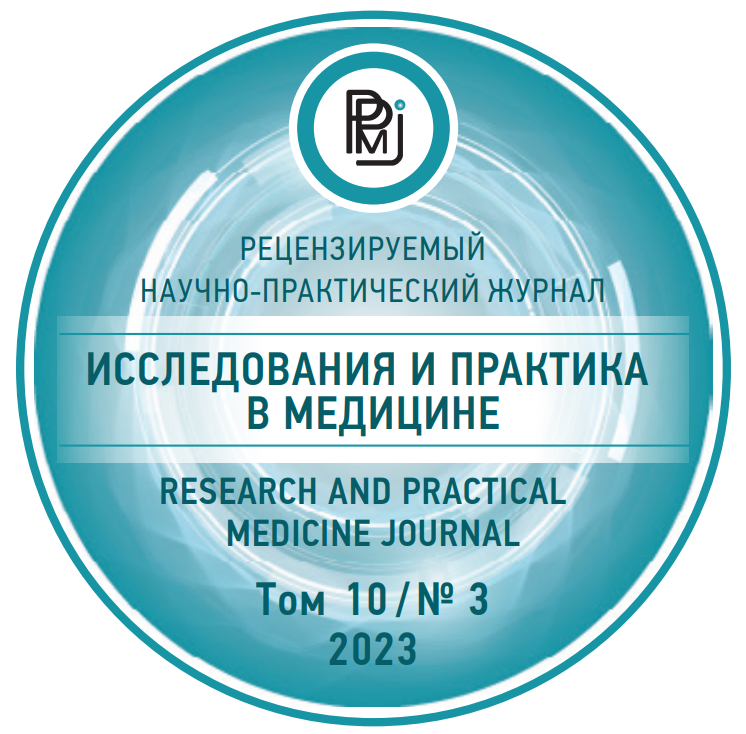Original Articles. Оncology
Purpose. To study the efficacy and safety of total neoadjuvant chemotherapy (NACT) with the FOLFIRINOX regimen for locally advanced gastric (GC) and cardioesophageal junction (CEJ) cancer.
Patients and methods. Patients with histologically confirmed locally advanced gastric adenocarcinoma and CEJ, clinical stage cT3 or higher and/or regional lymph node involvement (cN+), without evidence of distant metastasis were included in our open-label, single-centre, non-randomised study. In the FLOT control group, patients received 4 courses preoperatively and 4 postoperatively with follow-up. I In the FOLFIRINOX group 8 courses of chemotherapy were administered in neoadjuvant mode, followed by surgery and observation. The tumor regression grade was assessed in accordance with Becker, Mandard and G. A. Lavnikova scales.
Results. The study included 136 patients, 119 of whom started treatment according to the protocol (ITT population). Fiſty-nine patients were enrolled into the FLOT group and 60 into the FOLFIRINOX group. One-year progression-free survival (PFS) was 67,5 % in the FLOT group and 90,4 % in the FOLFIRINOX group (p = 0,29). The estimated 2-year PFS in the FLOT group was 61,4 % [95 % CI, 48,4–77,9 %]. Median PFS and overall survival (OS) were not reached. The incidence of events (progression or death) was lower in the FOLFIRINOX group (odds ratio [OR] 0,40 [95 % CI 0,16–0,97, p = 0,047]). Adverse prognostic factors regardless of treatment were lymphatic (L1), vascular (V1) and perineural invasion (Pn1), and regional lymph node involvement aſter chemotherapy (ypN+) [p = 0,046; p = 0,014; p = 0,0021; p = 0,04, respectively]. There was no correlation between pathological complete response and survival rates.
Conclusion. Total neoadjuvant chemotherapy with the FOLFIRINOX regimen for locally advanced GC/ CEJ demonstrated comparable to the perioperative FLOT one-year PFS rate. No association was found between tumor regression grade and survival outcomes.
Purpose. Determination of thyroid hormones (TH) and cortisol levels in blood in patients with breast cancer (BC) without previously detected endocrine pathology in the anamnesis.
Patients and methods. Twenty-five primary luminal A breast cancer patients before and aſter surgical removal of the tumour and 25 breast cancer patients with secondary metastatic brain lesions were examined. The levels of total and free forms of TH (T4, FT4, T3 FT3) and cortisol were determined in serum by RIA method.
Results. Before treatment in all patients with breast cancer the level of T3 was decreased 1.3 times and FT3 was increased 1.3 times (p < 0.05) against the background of normal TTH content. In 80 % of patients, blood cortisol concentration was 2 times higher than normal, and in 16 % of patients, T4 level was 1.8 times higher than normal (p < 0.05). Aſter tumour removal, FT3 levels in all patients and cortisol levels in 40 % of patients did not differ from normal. T4 content in 40 % of patients, and T3 and TTH in 28 % of women were above normal. A distinctive feature of patients with brain metastases of breast cancer was low T4 and cortisol levels in 36 % of patients against the background of low T3 levels.
Conclusions. Euthyroid sick syndrome was detected in all patients with BC: low serum T3 levels against the background of normal serum levels of TTH. Patients with primary BC were characterized by high concentrations of FT3 and cortisol, which could promote proliferation of malignant cells and decrease antitumour immunity. The condition of 1/3 of patients with brain metastases was aggravated by low levels of T4 and cortisol which could indicate the depletion of the main regulatory systems and an unfavorable disease prognosis.
Purpose. Evaluation of the effect of smoking on the immediate effectiveness (achievement of objective response – OR) of induction chemotherapy in patients receiving combined treatment for locally advanced HPV-positive squamous cell carcinoma of the oropharynx.
Patients and methods. Sixty-eight patients (51 men and 17 women) with locally advanced squamous cell cancer of the oropharynx associated with papillomavirus were included in the study, which was carried out from 2021 to 2023 at the P. Hertsen Moscow Oncology Research Institute – Branch of the National Medical Research Radiological Centre, Ministry of Health of the Russian Federation, Moscow, Russian Federation and the Municipal Clinical Oncological Hospital № 1 of the Department of Health of Moscow. The patients were divided into 2 equal groups, fully comparable in terms of the main characteristics (smoking history, stage, histological type, and degree of tumour differentiation). At the first stage, patients of the 1st (main) group received de-escalated induction chemotherapy: three 21-day courses according to the TR scheme (docetaxel in the dose of 75 mg/m2 + cisplatin 75 mg/m2); patients of the 2nd (control) group were treated with standard scheme (docetaxel 75 mg/m2 + cisplatin 75 mg/m2 + 5-fluorouracil 1000 mg/m2). Patients in both groups received prophylactic granulocyte colony-stimulating factor. At the second stage, standard chemoradiotherapy was carried out against the background of drug radiomodification with carboplatin. Correlation analysis was performed by calculating the Spearman coefficient with Bonferroni correction. Differences were considered reliable at p < 0.05.
Results. When evaluating the objective response to treatment, it was revealed that disease control was achieved in 33 (97 %) patients from group 1 and in all 34 (100 %) patients from group 2. Complete response was observed in 3 (8.8 %) patients from group 1 and 4 (11.8 %) from group 2; partial regression in 22 (64.7 %) and 24 (70.6 %); stabilisation of the tumour process in 8 (23.5 %) and 6 (17.6 %) respectively. Further analysis showed that there was no direct or inverse correlation between smoking and differentiated level of response (primary lesion, altered lymph nodes); all patients (smokers and those who had never smoked) responded equally effectively to the first stage of combined treatment, regardless of the ICT regimen.
Conclusion. In our study, no statistically significant effect of smoking on the immediate effectiveness of induction chemotherapy in the combined treatment of locally advanced HPV-associated squamous cell carcinoma of the oropharynx regardless of the induction regimen was found. However, a longer follow-up period is needed to evaluate the effect of smoking on long-term oncological outcomes.
Objective. Studying the levels of brain-derived neurotrophic factor (BDNF), nerve growth factor (NGF-β), and neurotrophin 3 (NT3) in the cerebral cortex and subcortical substance of female rats in an experimental model of extracerebral growth of malignant tumor under conditions of induced hypothyroidism.
Materials and methods. An experiment was performed on 47 white non-linear female rats: 10 rats each in the intact group, control group 1 (induced hypothyroidism), control group 2 (subcutaneous growth of Guerin’s carcinoma), main group (combination of pathologies); 7 rats in the group with subcutaneous tumor growth to assess life expectancy. Hypothyroidism was induced by per os administration of thiamazole (mercazolil, Akrikhin, Russia), daily dose of 2.5 mg/100 g of body weight, course of 30 days; total thyroxine and thyroid stimulating hormone were determined in blood serum by RIA (Immunotech, Czech Republic). When persistent hypothyroidism was achieved, Guerin’s carcinoma was transplanted under the skin as standard. Aſter decapitation on the 18th day aſter transplantation, the content of BDNF, NGF-β, NT3 (R&D System, RayBiotech, USA) was determined in 10 % homogenates of the cortex and subcortical substance subcortex of the brain (R&D System, RayBiotech, USA).
Results. In the cortex in control groups 1 and 2, the level of BDNF was 2.6- and 1.6-fold lower, respectively, and NGF-β was 2.2-fold higher on average than in the intact group. NT3 levels in the control group 1 were 3.0- and 1.6-fold lower in the cortex and subcortical substance, respectively. In the control group 2, the levels of NT3 and NGF-β were higher in the subcortical matter than in the intact group by 2.4-fold and 3.1-fold, respectively. In the cortex and subcortical substance in the main group, only NGF-β levels were higher on average by 1.7 times, with values being intermediate between the corresponding values in control groups 1 and 2.
Conclusion. Changes in the levels of all neurotrophins in hypothyroidism were most pronounced in the cortex, while in independent tumor growth, NGF-β in the cortex and subcortical substance and NT3 only in subcortical substance changed the most. When the pathologies were combined, only NGF-β was altered in the cortex and subcortical substance. Apparently, there is an interaction of the tumor and the CNS with changes in the balance of regulatory signals in the subcortical areas of the brain, that reflecting the connection with the biological characteristics of an active or inhibited (in presence of hypothyroidism) tumor growth.
Purpose. Obtaining extracranial diffuse tumor foci of glioblastoma in Balb/c Nude mice by implantation of mitochondria isolated from human glioblastoma.
Material and methods. Human glioblastoma mitochondria were isolated using differential centrifugation in a high speed refrigerated centrifuge. Mitochondrial samples were diluted with 0.9 % NaCl solution to a protein concentration of 3 mg of protein in 0.4 ml of saline. Balb/c Nude mice (N = 6) were intraperitoneally transplanted with freshly isolated glioblastoma mitochondria at the rate of 3 mg of protein per 1 animal in 0.4 ml of physiological solution. Male mice of Balb/c Nude line (N = 4), which were injected once intraperitoneally with 0.4 ml of physiological solution, served as control. All animals were euthanized by guillotine decapitation 17-21 days aſter parenteral implantation of mitochondria isolated from glioblastoma.
Results. Specific changes in the spleen structure were revealed (N = 4): the formation of strands of cells resembling glioblastoma multi-forme was observed in multiple fields of vision. The initiation of diffuse growth of glioblastoma cells in the stromal part of the red pulp of the spleen was evidenced by the expression of GFAP and ki-67, which were also recorded in the tumor preparation of the patient with glioblastoma. Morphological examination of the mesentery and lymph nodes revealed multiple areas with atypical cells resembling glioblastoma multiforme, localized in fibrous septa and sinuses. Stained granules with the corresponding immunohistochemical profile, GFAP and ki-6, were clearly defined in the mesentery and lymph node of a Balb/c Nude mouse (N = 6) aſter transplantation of human glioblastoma mitochondria. An additional study of the immunophenotype of cells in the spleen, mesentery, and lymph nodes of Balb/c Nude mice by the generally accepted marker S100 leſt no doubt about the induction of malignant growth aſter transplantation of mitochondria isolated from human glioblastoma.
Conclusions. Parenteral implantation of mitochondria isolated from human glioblastoma in male Balb/c Nude mice Might cause the growth and development of extracranial foci of glioblastoma in animals.
Review
Breast cancer (BC) is the most common malignant disease. The use of neoadjuvant drug therapy increases the likelihood of achieving a complete pathomorphological response (pCR), leads to an increase in resectability and ablation; helps to determine the sensitivity of tumor cells to chemopreventive agents, thereby improving the patient’s prognosis. Since pathomorphological assessment occurs aſter surgery, it is necessary to develop methods for non-invasive response assessment for timely correction of the volume of treatment. One such method is magnetic resonance imaging (MRI). Assessment of the obtained images using texture analysis allows to increase the accuracy of the method both in the control of neoadjuvant treatment and in the assessment of the response to neoadjuvant therapy during preoperative planning.
This article provides an analysis of the literature data on the potential to improve the prognostic value of breast MRI in assessing the complete pathomorphological response to neoadjuvant drug treatment of breast cancer using texture analysis of data.
Clinical and Laboratory Observations
Purpose of the study. The purpose of the study was to compare the effect of spinal and general anesthesia on the incidence of postoperative complications aſter hernioplasty and on the dynamics of the frailty index (FI) in elderly patients with inguinal hernia.
Patients and methods. 78 patients diagnosed with inguinal hernia were involved in the study (average age was 70.1 ± 0.8 years). Patients underwent open hernia repair and Lichtenstein plasty of the posterior wall of the inguinal canal. The patients were divided into two groups depending on the type of anesthesia: spinal anesthesia (SA; N = 65) and general anesthesia (GA; N = 13). At the time of admission, 30 days aſter the surgery, the FI was calculated using the Edmonton questionnaire.
Results. In the SA group, 39 patients (60 %) had a FI ≥ 7; 9 patients (13.8 %) had a FI ≥ 9; 8 patients (12.3 %) had a FI ≥ 11; and 9 patients (13.8 %) had the highest FI ≥ 12. At 30 days aſter surgery, 20 patients (30.8 %) showed a decrease in FI values (FI from 7 to 9 decreased almost 2-fold). In the GA group, on the day of admission, 6 patients (46.2 %) had FI ≥ 7, 5 (38.5 %) had FI ≥ 9, and 2 (15.4 %) had FI ≥ 11. At 30 days aſter surgery, no changes were observed in patients with FI ≥ 7.
Conclusion. In the spinal anesthesia group, urinary retention was predominant among complications, while in patients aſter general anesthesia, pulmonary atelectasis prevailed among complications. The use of spinal anesthesia for hernioplasty was accompanied by a decrease in the frailty index within 30 days aſter surgery in individuals with a FI ≥ 7. In the GA group, decrease in the index within 30 days aſter surgery was observed in patients with FI ≥ 9.
Clinical Case Reports
Treatment of patients with metastatic castration-resistant prostate cancer in clinical practice is a vital necessity and a challenging task since the causes of castration resistance are not fully understood. Adherence to treatment regimens in accordance with the National Clinical Guidelines allows to achieve an increase in both overall survival and progression-free survival, as well as to reduce the mortality rate in this category of patients. Administration of 1st-line treatment regimens stabilizes the disease in the majority of pancreatic cancer patients; in some cases, the disease becomes aggressive, distant metastases appear, most oſten in bones, lymph nodes, and internal organs, as demonstrated by three clinical observations presented in this article. The administration of enzalutamide (in 2 cases) and abiraterone acetate (in 1 case) at the stage of resistance to castration therapy allowed to obtain a complete “response” from visceral lesions, stabilise bone metastatic foci and increase the life expectancy of patients.
The article presents a rare clinical observation of patient S., 50 years old, a long-term sufferer of urolithiasis, who was admitted to the urological department of the hospital with a clinical picture of renal colic on the leſt side, exacerbation of chronic pyelonephritis. From the anamnesis: in 2021, internal stenting of both ureters was performed as indicated. Despite detailed recommendations at discharge, the patient did not consult doctors or take any medications until 2023. The examination revealed that the cause of exacerbation of chronic pyelonephritis and impaired urine outflow were encrusted (“forgotten”) stents in both ureters, in the leſt of which there was a concrement obstructing urine outflow. Ureteroscopy on the right side, stent fragments extraction; ureteroscopy on the leſt side, contact lithotripsy, removal of the encrusted ureteral stent; urinary passage and independent urination were restored. Despite technical difficulties during the surgical intervention, the postoperative period proceeded without complications.



